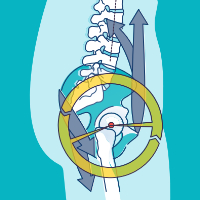Available evidence and clinical experience gained as an occupational therapist (OT) underpins my opinion that the position of the pelvis can impact on a client’s seated position when showering and toileting.
A client with a posterior tilted pelvis frequently presents with altered natural curves of the spine. Flexion in the thoracic spine encourages a kyphosis (C shaped spine) which compromises spinal alignment and the head position is pushed forward. In many cases clients are at an increased risk of slipping down or even off the seated equipment. During this position the ischial tuberosities are no longer sited for stability and slide forward into the seat base. This can then lead to potential skin shearing on the buttocks and possible pressure risks on the spine, due to an increased spinal contact point on the back rest. The action of slipping down frequently causes positioning issues on the seat and an increased manual handling risk to the client’s family/carer.

The change in pelvis position and flexion in the spine reduces the likelihood of sitting central over the equipment aperture, affecting the person’s ability to urinate/defecate and the bodily waste hitting the toilet/commode pan. Also, reduced positioning over the aperture can lead to decreased access to essential lower body areas, to maintain personal hygiene needs.
In many cases, a change in pelvis/spinal alignment creates a closed posture. This reduces upper limb movement, affecting independence in personal care tasks during showering and toileting.
Unfortunately, with severe postural complications, I’ve also witnessed swallowing problems, speech difficulties, respiratory complications, bowel/bladder issues and detrimental effects on spinal nerves leading to numbness.
Working in numerous occupational therapy assessment teams over my career, I’ve triaged and assessed many referrals requesting an equipment assessment for the reported reasons “the client is unable to sit up straight and is slipping down in the shower chair”. “The bodily waste is not hitting the toilet/commode pan”.
Sometimes we can clinically unpick the potential causes for a referral, but an individual assessment is always required to understand a client’s needs, what is important to them and their goals. The client’s clinical presentation helps review possible reasons for a postural change.
I always like to review the client’s current equipment to determine whether the equipment is encouraging a posterior tilt i.e., incorrect seat depth or possibly the client’s feet are not in contact with the footrests/floor.
During the assessment, having knowledge of a neutral sitting posture is valuable and being able to establish whether a pelvis position/kyphosis is fixed or flexible in position. This information will influence equipment selection and set up, depending on whether you are promoting a neutral sitting position or whether you need to accommodate for a fixed pelvis position/spinal change.
When selecting the appropriate equipment, it needs to be comfortable, meet their individual needs and the environment.
My following list is not complete, but aims to summarise the equipment features I respect as valuable when selecting personal care equipment for clients with a posterior tilt and kyphotic spine:
- An appropriate seat base offering comfort, pelvic stability and suitably sized aperture to accommodate changes in pelvis position.
- Adjustment of the equipment to provide the correct seat depth and footrest/ floor to seat height.
- A suitable back rest option to support comfort and postural changes.
- A tilt in space option provides postural management for fixed postural changes.
- The long-term flexibility of the equipment including further adjustments and accessories is recommended to meet current and potential client future needs.
Gayle Cardwell
Independent Occupational therapist
Please note my views expressed in this blog are for information purposes only, and all client recommendations should be made once an individual assessment is complete by a suitable professional.

Latest Blog Posts
Seasonal opening times 2025/26
2025 Holiday Season Update - Our team are here for you but we will be taking a break between the 24th December and 2nd January 2025.

New Shower Chair Innovation
Experience Wealden Rehab’s new shower chair innovation at the OT Show 2025

Responsive Care Equipment Supplier Across the UK
Supporting hospitals and care providers in unsettling times ...

NAEP Conference 2025
Meeting Occupational Therapists, Commissioners and Exploring Bariatric and Paediatric Solutions

Our Seasonal opening times 2024/25
Our team are here for you but we will be taking a break between the 24th December and 2nd January 2025.

Can a RAZ shower chair rust?
Get an in-depth look at the RAZ shower chair range and the protective features that make them built to last



